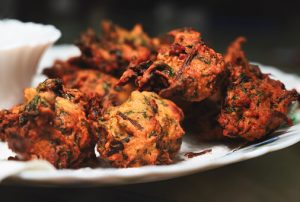Pakora r (also known as pakoda, pakodi, oponako) is a popular Indian food. These fritters are perfect for cold winter evenings since they are piping hot and crunchy. They\’re usually made up of sliced or chopped vegetables or cottage cheese cubes wrapped in a chickpea flour batter, deep-fried in hot oil, and served with chutneys.
The origin of pakora
Pakoras are thought to have originate in Gujarat, India\’s westernmost state. Pakoras are a traditional Gujarati teatime snack. Rain showers are a common excuse in Punjabi households for tea and pakoras. Bondas, a potato-based version, are also quite popular in South India.
In India\’s southern states, such dishes are referre to as bajji rather than pakora. They look a lot like Mauritian bhajas.
Pakoras are commonly served as snacks or appetisers, but they can also be used to make main dishes such as pakora curry, also known as kadhi. In which pakoras are cook in a thick chickpea flour and sour yoghurt gravy.
Interesting fact
On their voyage to Japan in the sixteenth century, Portuguese and Spanish ships would stop in India. They would seek out Indian cooks and eventually experiment with Indian cuisine. These chefs were responsible for teaching Europeans to appreciate vegetables, particularly pakoras. When the ships docked in Japan, some of the chefs disembarked and stayed.
The majority of historians think that Indian pakora (also known as bhajiya) was the forerunner of tempura. In fact, until the Portuguese traders arrived, there was no mention of tempura in Japanese cuisine. Panko and tonkatsu were also introduce by the Portuguese.

